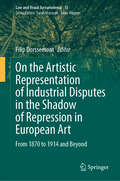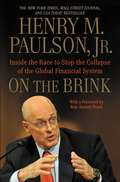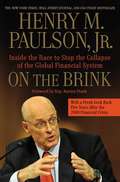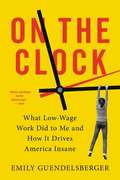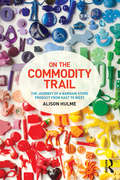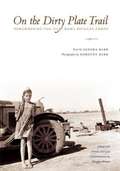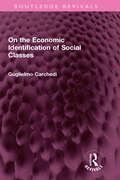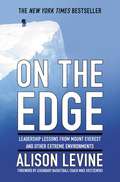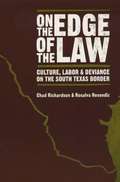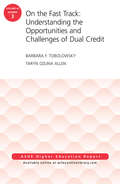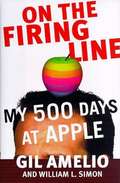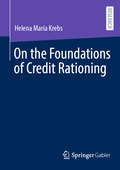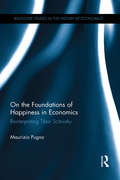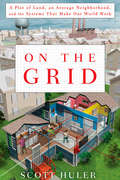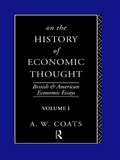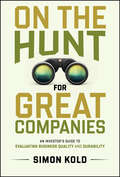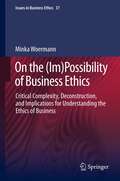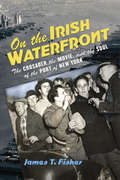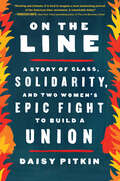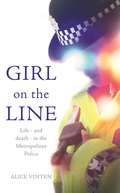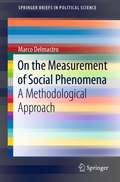- Table View
- List View
On the Artistic Representation of Industrial Disputes in the Shadow of Repression in European Art: From 1870 to 1914 and Beyond (Law and Visual Jurisprudence #15)
by Filip DorssemontThis book is the first volume on the artistic representation of industrial disputes in European art (from 1870 to 1914) since the catalogue of the landmark exhibition Streik, Realität und Mythos, organized by the Deutsches Historisches Museum (1992). It has been written by a group of scholars who share a keen interest in social history and the history of art, as well as in-depth knowledge of industrial relations and collective labour law. Seeking to transcend a purely western European perspective, the book offers unprecedented insights into artistic production in Poland and Hungary from the 19th century to the communist era. It even goes beyond the European continent, examining the United States and Mexico. The media explored include painting, sculpture, the graphic arts and photography. Further, the book deals with artists great (Carlo Carrà, Walter Crane, James Ensor, Juan Gris, Käthe Kollwitz, Constantin Meunier,Mihály Munkácsy, Théophile-Alexandre Steinlen and Jan Toorop) and small, sometimes even anonymous. The artistic styles range from (social) realism, naturalism and neo-impressionism to futurism and socialist realism. All stages of industrial disputes (from the causes of strikes to their violent suppression) are subjected to iconographical and iconological analysis, combined with perspectives from visual studies, critical art and gender studies. Agricultural workers, miners, construction workers and textile workers fill the scenes. Most of them are subordinate workers; others are (bogus) independent workers and migrant workers. Given its scope, the book will be of interest to (art) historians, labour law scholars, and specialists in industrial relations.
On the Brink: Inside the Race to Stop the Collapse of the Global Financial System -- With Original New Material on the Five Year Anniversary of the Financial Crisis
by Henry M. PaulsonFormer Secretary of the Treasury Hank Paulson -- who was at the very epicenter of the crashing financial markets -- provides a startling, first- person account of what really happened during this time of global financial crisis - and this revised edition features fresh and original material from Paulson on the five-year-anniversary of the 2008 financial crisis.From the man who was in the very middle of this perfect economic storm, Paulson puts the reader in the room for all the intense moments as he addressed urgent market conditions, weighed critical decisions, and debated policy and economic considerations with of all the notable players-including the CEOs of top Wall Street firms as well as Ben Bernanke, Timothy Geithner, Sheila Bair, Nancy Pelosi, Barney Frank, presidential candidates Barack Obama and John McCain, and then-President George W. Bush.More than an account about numbers and credit risks gone bad, ON THE BRINK is an extraordinary story about people and politics-all brought together during the world's impending financial Armageddon.
On the Brink: Inside the Race to Stop the Collapse of the Global Financial System
by Henry M. Paulson Jr.ON THE BRINK is Hank Paulson's first-person account of the catastrophic economic events of 2008. From the man who was in the very middle of this perfect economic storm, Paulson puts the reader in the room for all the intense moments as he addressed urgent market conditions, weighed critical decisions, and debated policy and economic considerations with of all the notable players-including the CEOs of top Wall Street firms as well as Ben Bernanke, Timothy Geithner, Sheila Bair, Nancy Pelosi, Barney Frank, presidential candidates Barack Obama and John McCain, and then-President George W. Bush. More than an account about numbers and credit risks gone bad, ON THE BRINK is an extraordinary story about people and politics-all brought together during the world's impending financial Armageddon.
On the Bubble: Startup Bootstrapping
by Annelena Lobb Jeffrey J. Bussgang Tom QuinnBubble was a software company in the low-code/no-code market, making tools that allowed users without traditional programming backgrounds or technical skills to build software. The case covers cofounder Joshua Haas's engineering background, as he experienced a high demand for coding expertise in the startup community, but a low supply of coders. It then outlines his founding, with cofounder Emmanuel Straschnov, of Bubble in 2012, and their subsequent bootstrapping for six years until 2018, when a well-known tech entrepreneur and angel investor offered them an attractive financing deal. The case covers Bubble's product-led growth, or a singular focus on the product (as opposed to investing in sales and marketing) as a strategy for user acquisition and retention. The case also covers the difficulties of hiring new employees, and Bubble's strategy for building a team.
On the Clock: What Low-Wage Work Did to Me and How It Drives America Insane
by Emily GuendelsbergerThe bitingly funny, eye-opening story of a college-educated young professional who finds work in the automated and time-starved world of hourly laborAfter the local newspaper where she worked as a reporter closed, Emily Guendelsberger took a pre-Christmas job at an Amazon fulfillment center outside Louisville, Kentucky. There, the vending machines were stocked with painkillers, and the staff turnover was dizzying. In the new year, she travelled to North Carolina to work at a call center, a place where even bathroom breaks were timed to the second. And finally, Guendelsberger was hired at a San Francisco McDonald's, narrowly escaping revenge-seeking customers who pelted her with condiments.Across three jobs, and in three different parts of the country, Guendelsberger directly took part in the revolution changing the U.S. workplace. ON THE CLOCK takes us behind the scenes of the fastest-growing segment of the American workforce to understand the future of work in America - and its present. Until robots pack boxes, resolve billing issues, and make fast food, human beings supervised by AI will continue to get the job done. Guendelsberger shows us how workers went from being the most expensive element of production to the cheapest - and how low wage jobs have been remade to serve the ideals of efficiency, at the cost of humanity.ON THE CLOCK explores the lengths that half of Americans will go to in order to make a living, offering not only a better understanding of the modern workplace, but also surprising solutions to make work more humane for millions of Americans.
On the Commodity Trail: The Journey of a Bargain Store Product from East to West (Criminal Practice Ser.)
by Alison HulmeFollowing the journey of eight bargain store objects, Alison Hulme reveals the complex story behind society’s simplest and cheapest commodities. Inspired by Walter Benjamin’s Arcades Project, On the Commodity Trail explores the colourful and fascinating histories of everyday objects.Along the way, we observe raw materials on municipal rubbish dumps in China, newly re-made products in the world’s largest wholesale market, and take a journey across the seas, to bargain stores in Europe and North America, arriving finally in the homes of consumers. Weaving together narratives from the people we meet at different parts of the commodity chain – waste peddlers, wholesalers, store owners, and shoppers – the book examines the places and people at the heart of these localized yet immense global networks.Unlike other investigations of commodity chains, this study does not chart a straightforward trajectory from production to consumption. Instead, it demonstrates that the low-end commodity chain is one of constant rupture in which products are made and re-made, blurring the dividing line between producing and consuming.An ethnography of material culture as well as an examination of commodity culture at a time of economic downturn, this deeply-engrossing book makes a unique contribution to our understanding of commodity chains and consumer culture.
On the Dirty Plate Trail: Remembering the Dust Bowl Refugee Camps
by Sanora BabbThe 1930s exodus of "Okies" dispossessed by repeated droughts and failed crop prices was a relatively brief interlude in the history of migrant agricultural labor. <P><P>Yet it attracted wide attention through the publication of John Steinbeck's The Grapes of Wrath (1939) and the images of Farm Security Administration photographers such as Dorothea Lange and Arthur Rothstein. Ironically, their work risked sublimating the subjects--real people and actual experience--into aesthetic artifacts, icons of suffering, deprivation, and despair. Working for the Farm Security Administration in California's migrant labor camps in 1938-39, Sanora Babb, a young journalist and short story writer, together with her sister Dorothy, a gifted amateur photographer, entered the intimacy of the dispossessed farmers' lives as insiders, evidenced in the immediacy and accuracy of their writings and photos. Born in Oklahoma and raised on a dryland farm, the Babb sisters had unparalleled access to the day-by-day harsh reality of field labor and family life.
On the Economic Identification of Social Classes (Routledge Revivals)
by Guglielmo CarchediFirst published in 1977, On the Economic Identification of Social Classes centres around the economic identification – the definition in terms of production relations – of social classes, focussing on the developed capitalist countries. The basic stages of capitalist development are considered, with special emphasis on monopoly capitalism. The book includes a detailed analysis of the functional element of the capitalist production relations; the identification, in terms of production and distribution relations, of the new middle class under monopoly capitalism; and the analysis of the process of proletarianism of this class. New theoretical concepts – of position, devaluation of labour power through dequalification of positions, and of capitalist and non-capitalist state activities – are developed to further the discussions, which, although fresh in approach, are immersed in the complex texture of Marxist thought. This book will be of interest to students of economics and sociology.
On the Edge: Leadership Lessons from Mount Everest and Other Extreme Environments
by Alison LevineOn the Edge is an engaging leadership manual that provides concrete insights garnered from various extreme environments ranging from Mt Everest to the South Pole. By reflecting on the lessons learned from her various expeditions, author Alison Levine makes the case that the leadership principles that apply in extreme adventure sport also apply in today's extreme business environments. Both settings require you to be able to make crucial decisions on the spot when the conditions around you are far from perfect. Your survival -and the survival of your team-depend on it. Featuring a Foreword from legendary Duke University basketball coach Mike Krzyzewski who knows all about leadership, On the Edge provides a framework to help people scale whatever big peaks they aspire to climb-be they literal or figurative-by offering practical, humorous, and often unorthodox advice about how to grow as a leader.
On the Edge: The Art of Risking Everything
by Nate SilverIn the bestselling The Signal and the Noise, Nate Silver showed how forecasting would define the age of Big Data. Now, in this timely and riveting new book, Silver investigates “the River,” the community of like-minded people whose mastery of risk allows them to shape—and dominate—so much of modern life. <P><P> These professional risk-takers—poker players and hedge fund managers, crypto true believers and blue-chip art collectors—can teach us much about navigating the uncertainty of the twenty-first century. By immersing himself in the worlds of Doyle Brunson, Peter Thiel, Sam Bankman-Fried, Sam Altman, and many others, Silver offers insight into a range of issues that affect us all, from the frontiers of finance to the future of AI. <P><P> Most of us don’t have traits commonly found in the River: high tolerance for risk, appreciation of uncertainty, affinity for numbers—paired with an instinctive distrust of conventional wisdom and a competitive drive so intense it can border on irrational. For those in the River, complexity is baked in, and the work is how to navigate it. People in the River have increasing amounts of wealth and power in our society, and understanding their mindset—and the flaws in their thinking— is key to understanding what drives technology and the global economy today. <P><P> Taking us behind the scenes from casinos to venture capital firms, and from the FTX inner sanctum to meetings of the effective altruism movement, On the Edge is a deeply reported, all-access journey into a hidden world of power brokers and risk-takers. <p> <b>New York Times Bestseller</b>
On the Edge of the Law: Culture, Labor, and Deviance on the South Texas Border
by Chad Richardson Rosalva ResendizThe Valley of South Texas is a region of puzzling contradictions. Despite a booming economy fueled by free trade and rapid population growth, the Valley typically experiences high unemployment and low per capita income. <P><P>The region has the highest rate of drug seizures in the United States, yet its violent crime rate is well below national and state averages. The Valley's colonias are home to the poorest residents in the nation, but their rates of home ownership and intact two-parent families are among the highest in the country for low-income residential areas. What explains these apparently irreconcilable facts?
On the Edges of Development: Cultural Interventions (Routledge Studies in Development and Society)
by Kum-Kum Bhavnani John Foran Priya Kurian Debashish MunshiBig business, financial institutions, and capitalist powers have wreaked much havoc on the Third World in the name of development. This book re-imagines development through a careful and imaginative exploration of some of the many ways that culture – in the broadest sense of lived experience and its representation – can recenter resistance, suggest alternative models, and advance critiques of development as it is currently practiced. The diverse group of scholars and activists who contribute chapters to the volume engage with the puzzle of how best to conceptualize an alternative development that improves the living conditions of women and men in different parts of the world and simultaneously demands solutions that focus on the integration of gender, diversity, and development with the realities of people’s lives.
On the Fast Track: Understanding the Opportunities and Challenges of Dual Credit, AEHE 42:3
by Aehe Barbara F. Tobolowsky Taryn Ozuna AllenThe dual-credit curricular initiative offers high school students the opportunity to earn college and high school credits simultaneously without taking a standardized test to acquire the credit. The courses are purported to introduce students to a more rigorous curriculum in high school and save them time and money in their pursuit of college degrees. Dual credit programs have grown rapidly, and this monograph provides a synthesis of: * the scholarly literature on dual credit offered at high school and a variety of postsecondary settings; * underrepresented students' experiences with the course(s), and * suggestions for future research and drivers that will influence its development. Originally, these initiatives focused on high-achieving students, but additional models have emerged that expand the benefits to lower- and middle-achieving students as well. This is the third issue of the 42nd volume of the Jossey-Bass series ASHE Higher Education Report. Each monograph is the definitive analysis of a tough higher education issue, based on thorough research of pertinent literature and institutional experiences. Topics are identified by a national survey. Noted practitioners and scholars are then commissioned to write the reports, with experts providing critical reviews of each manuscript before publication.
On the Firing Line: My 500 Days at Apple
by William L. Simon Gil AmelioFormer CEO of Apple Computer Gil Amelio, who was replaced by Steve Jobs in the summer of 1997, now chronicles his 17 months as head of Apple and reveals the inner workings of a company shrouded in myth and mystery. "On the Firing Line" is Gil Amelio's Up Close and Personal story that dares to unmask the personalities behind Apple Computer and lay bare the facts Apple fans don't know. It untangles the issues involved in Apple's desperate search for a CEO, describes how Steve Jobs claimed that Amelio was the only one who could save the company, and then shows how Jobs played a critical role in manipulating the board of directors to fire Amelio. In an engaging style, Amelio explores many of the problems he confronted as CEO and reveals how he constantly suffered a culture clash with the company and its people -- a clash he describes in terms of Brioni suits and oxfords meeting Levi's "TM" and Birkenstocks. A must-have for every Apple fan and computer world aficionado, this candid, often startling book takes readers inside the boardrooms and computer labs to reveal the way things really are at the company that has become an American icon.
On the Foundations of Credit Rationing
by Helena Maria KrebsHelena Maria Krebs analyzes equilibrium credit rationing when banks compete for loans and deposits in a double-sided Bertrand game. Borrowers and lenders are allowed to switch market sides. Thus, investors do not only base their decisions on loan rates, but also on opportunity costs in the form of deposit rates. Credit rationing may occur if adverse selection due to borrowers’ informational advantage leads to a lower expected return on loans if the loan rate increases. In that case, banks may have an incentive to offer loan rates below the market-clearing rate. At these rates loan demand exceeds loan supply. The author reveals the important role of bank equity and its distribution: Banks with high equity offer cheap loans and reject superfluous loan applicants, whom banks with low equity then offer expensive loans. Thereby expensive banks realize a higher expected return on loans thancheap banks. Furthermore, this book is the first to formally model the process of acceptance and rejection of loan applicants as a separate stage of the double-sided Bertrand game after banks have decided on their interest rates. It is shown that for fixed chosen interest rates, the deposit and loan volumes of all banks in a subgame perfect Nash equilibrium of the resource allocation game are uniquely determined.
On the Foundations of Happiness in Economics: Reinterpreting Tibor Scitovsky (Routledge Studies in the History of Economics)
by Maurizio PugnoEconomic growth has extraordinarily increased the availability of market goods to satisfy people’s need for comfort, but at the same time it has also raised great challenges to their working and family life. Will people learn the skill necessary to cope with these challenges and draw full enjoyment from economic growth? On the Foundations of Happiness in Economics explores this question by examining the work of Tibor Scitovsky, author of The Joyless Economy. Given the recent rise of behavioural economics and happiness economics, this book aims to show how far ahead of his time Scitovsky was in his work on individual welfare (or wellbeing). It traces the evolution of Scitovsky’s original thought, arguing that he has been frequently misunderstood, before undertaking formal analysis in order to demonstrate how far his work anticipated or even went beyond the recent advances in economics. This volume also explores Scitovsky’s work in the context of Keynes’ work on wellbeing, offering a new perspective on welfare in the history of economic thought. Other issues discussed in this text regard creativity and social skills, hedonism and eudaimonia, parenting and education, addiction, work/leisure balance, policies for happiness, paternalism, and the quality of economic growth. This book addresses a variety of readers, such as those interested in the history of economics, as well as students and researchers concerned with the economic theory of well-being.
On the Grid: A Plot of Land, an Average Neighborhood, and the Systems That Make Our World Wor k
by Scott HulerTurn on a switch and from the nearest bulb out pours light from... somewhere; turn on a faucet and water appears. Wires, pipes, and roads support the lives we lead, but the average person doesn't know where they go or even how they work. In On the Grid, Scott Huler takes the time to understand the systems that sustain our way of life, starting from his own quarter of an acre in North Carolina and traveling as far as ancient Rome.Each chapter follows one element of infrastructure back to its source. Huler visits power plants, watches new asphalt pavement being laid, and traces a drop of water backward from the faucet to the Gulf of Mexico. He reaches out to guides along the way, both the workers who operate these systems and the people who plan them.On the Grid brings infrastructure to life and details the ins and outs of our civilization with fascinating, back-to-basics information about the systems we all depend on.
On the Grid: Life Behind the Scenes of Formula 1
by Luke Smith“One of the finest wordsmiths in modern sport . . . with infectious passion and singular craft [Smith] has created a truly fabulous and unique piece of work. On the Grid is incredibly special. I loved every thoughtfully written word.” —Will Buxton, award-winning broadcaster, star of Drive to Survive and New York Times bestselling author of Grand Prix: An Illustrated History of Formula 1“Even if you think you know everything there is to know about Formula 1, you'll learn something within these pages.” —GP Racing MagazineLearn how Formula One is the world’s greatest team sport with this intimate and colorful insider’s account of what really happens on—and off—the race track, from The Athletic’s senior F1 writer who has been following the sport around the world for over a decade.Formula One has only 20 drivers in its elite ranks, but behind each one is an army of professionals devoted to the sport: statisticians and strategists, engineers and mechanics, PR gurus and party planners, and more—all who spend months traveling thousands of miles across the globe each year. Their achievements (and failures) may not be as well-publicized as those of the drivers and team principals, but they’re just as important: one fifty-cent screw in the wrong place could cause a $15 million car to break down mid-race.In On the Grid, F1 journalist Luke Smith brings to life the behind-the-scenes stories that don’t make it to viewers’ screens. From the Bahrain starting grid—thick with sweat and engine fumes—to opulent yacht parties in Monaco, with a stopover at a legendary bakery in Melbourne whose croissants exist only because of F1 technology, he showcases the extraordinary characters who give the sport such color and intrigue. With deep insight, knowledge, and warmth, he writes about the emotions and struggles that come with working in such a high-pressure and inherently dangerous sport, and the efforts being made to improve its class and racial diversity, gender parity, and environmental impact. The result is a richer, broader, and more inclusive look at F1 than ever before—perfect for longtime fans and Drive to Survive neophytes alike.
On the History of Economic Thought (British and American Economic Essays)
by A. W. CoatsOn the History of Economic Thought is introduced by an essay in intellectual autobiography outlining the development of Coats key ideas and the distinctive elements of his approach. Two themes in particular emerge. The first is the difference between British and American economics, both in content and in the practice of the profession. This is an important element in all areas of his research. The second theme is in the interrelationships between economic ideas, events (or conditions) and policy issues. The book concludes by offering an assessment of the current state of the discipline indicating the advantages an historian of economics can offer as a commentator on recent developments.
On the Hunt for Great Companies: An Investor's Guide to Evaluating Business Quality and Durability
by Simon KoldEssential investment guide to perform sophisticated practical analysis on long-term business quality An unparalleled practical training tool for investment analysis, On the Hunt for Great Companies: An Investor's Guide to Evaluating Business Quality and Durability helps readers move beyond using rules of thumb for companies or investment hypotheses based on broad-level pattern recognition and instead start using a more thorough approach through sophisticated empirical analysis. Readers will learn how to assess all the essential traits of a good business, including passionate management, staying power, abnormal reinvestment options, low dependency risk, and to identify emerging quality. This book is supported by a wealth of real-world examples, both contemporary and historical, detailed original illustrations, and true business stories and anecdotes from investor and former comedian Simon Kold. In this book, readers will learn about: Elements of intense and durable competitive advantage such as scale economies, switching costs, network effects, brands, proprietary resources, and modest value extraction Methods to formulate falsifiable test statements and empirically test those predictions, rather than relying on heuristics or box-checking Incorporates memorable investment advice through Kold’s trademark humorous style Detailed, sophisticated, and highly actionable, On the Hunt for Great Companies is an essential for professional investors of all sizes, in all industries, in both public and private markets.
On the (Im)Possibility of Business Ethics: Critical Complexity, Deconstruction, and Implications for Understanding the Ethics of Business
by Minka WoermannCorporations, and the environments in which they operate, are complex, with changing multiple dimensions, and an inherent capacity to evolve qualitatively. A central premise of this study is that a postmodern reading of ethics represents an expression of, and an engagement with, the ethical complexities that define the business landscape. In particular, the deconstructive philosophy of Jacques Derrida offers a non-trivial reading of a complex notion of ethics, and thereby helps us to develop the skills necessary to critique and intervene in our practices, and to develop robust strategies for living in the absence of prescriptive ethical frameworks. Although a central premise of this study is that substantive ethical claims can only be generated within a given context, the study nevertheless presents readers with a meta-position that illustrates the type of considerations that should inform ethical reflection from a complexity perspective. In order to illustrate the value that this meta-position holds for business ethics, these considerations are explored in terms of the implications that they hold for our understanding of corporate social responsibility, for the practice of responsible management and leadership practices, and for teaching business ethics.
On the Irish Waterfront: The Crusader, the Movie, and the Soul of the Port of New York
by James T. FisherSite of the world's busiest and most lucrative harbor throughout the first half of the twentieth century, the Port of New York was also the historic preserve of Irish American gangsters, politicians, longshoremen's union leaders, and powerful Roman Catholic pastors. This is the demimonde depicted to stunning effect in Elia Kazan's On the Waterfront (1954) and into which James T. Fisher takes readers in this remarkable and engaging historical account of the classic film's backstory. Fisher introduces readers to the real Father Pete Barry featured in On the Waterfront, John M. Pete Corridan, a crusading priest committed to winning union democracy and social justice for the port's dockworkers and their families. A Jesuit labor school instructor, not a parish priest, Corridan was on but not of Manhattan's West Side Irish waterfront. His ferocious advocacy was resisted by the very men he sought to rescue from the violence and criminality that rendered the port a jungle, an outlaw frontier, in the words of investigative reporter Malcolm Johnson. Driven off the waterfront, Corridan forged creative and spiritual alliances with men like Johnson and Budd Schulberg, the screenwriter who worked with Corridan for five years to turn Johnson's Pulitzer Prize-winning 1948 newspaper exposé into a movie. Fisher's detailed account of the waterfront priest's central role in the film's creation challenges standard views of the film as a post facto justification for Kazan and Schulberg's testimony as ex-communists before the House Committee on Un-American Activities. On the Irish Waterfront is also a detailed social history of the New York/New Jersey waterfront, from the rise of Irish American entrepreneurs and political bosses during the World War I era to the mid-1950s, when the emergence of a revolutionary new mode of cargo-shipping signaled a radical reorganization of the port. This book explores the conflicts experienced and accommodations made by an insular Irish-Catholic community forced to adapt its economic, political, and religious lives to powerful forces of change both local and global in scope.
On the Line: A Story of Class, Solidarity, and Two Women's Epic Fight to Build a Union
by Daisy Pitkin&“Riveting and intimate. It is hard to imagine a more humanizing portrait of the American labor movement. A remarkable debut.&” —Francisco Cantú, New York Times bestselling author of The Line Becomes a River On the Line takes readers inside a bold five-year campaign to bring a union to the dangerous industrial laundry factories of Phoenix, Arizona. Workers here wash hospital, hotel, and restaurant linens and face harsh conditions: routine exposure to biohazardous waste, injuries from surgical tools left in hospital sheets, and burns from overheated machinery. Broken U.S. labor law makes it nearly impossible for them to fight back. The drive to unionize is led by two women: author Daisy Pitkin, a young labor organizer, who addresses this exhilarating narrative to Alma Gomez García, a second-shift immigrant worker, who risks her livelihood to join the struggle and convinces her fellow workers to take a stand. Forged in the flames of a grueling legal battle and the company&’s vicious anti-union crusade, including the retaliatory firing of Alma, the relationships that grow between Daisy, Alma, and the rest of the factory workers show how a union, at its best, can reach beyond the workplace and form a solidarity so powerful that it can transcend friendship and transform communities. But when political strife divides the union, and her friendship with Alma along with it, Daisy must reflect on her own position of privilege and the complicated nature of union hierarchies and top-down organizing. Daisy Pitkin looks back to uncover the forgotten roles immigrant women have played in the U.S. labor movement and points the way forward. As we experience one of the largest labor upheavals in decades, On the Line shows how difficult it is to bring about social change, and why we can&’t afford to stop trying.
On the Line: Life – and death – in the Metropolitan Police
by Alice Vinten'A warts-and-all memoir of an ex-cop from probationer days on. Fascinating' IAN RANKIN'A humane but unflinching look at the sharp end of contemporary policing' LUKE JENNINGS'I loved this book. Gritty and gripping, moving and shocking, this brilliant police memoir shows that life on the force really is different for girls' ERIN KELLY Welcome to London. Population: 8.7 million. And it's your job to keep them safe. A no-holds-barred account of life on the front line of policing, On the Line follows PC Alice Hearn throughout ten years in the Met, from rookie to constable. As she deals with violent criminals, heart-breaking domestic situations, petty crime, life, death, and everything in between, she builds up a portrait of a living, complex city, and what it means to look after it.'COMPELLING' Sunday Express 'EXTRAORDINARY' Mail on Sunday'I've never read such an authentic and interesting account of what it's like to be a female police officer' LOUISE VOSS'Deeply moving and inspiring' JANE CASEY'Alice Vinten is the real deal - all the thrills of a crime novel, only true' MEL MCGRATH 'Heartbreaking, funny and, most of all, honest' LISA CUTTS 'Compelling, honest and moving' LAURA WILSON
On the Measurement of Social Phenomena: A Methodological Approach (SpringerBriefs in Political Science)
by Marco DelmastroThis book explores the analysis of social phenomena, using a multidisciplinary approach while addressing statistical, economic, sociological, as well as psychological issues.The author presents a detailed account of the procedures and techniques used to gather, process, and analyze data. Topics covered include, but are not limited to survey data, content analysis data, data visualization, as well as data about crimes.The book addresses this methodological framework that drives applied social sciences in an applicative and simple way, by analyzing key social phenomena such as the threats to journalism, the so-called chilling effect, and the market for news. Finally, the author examines the data and measures of the recent COVID-19 pandemic.This book is a must-read for everybody interested in a better understanding of the methodological analysis of social phenomena, social and political methodology, and applied science in general.
